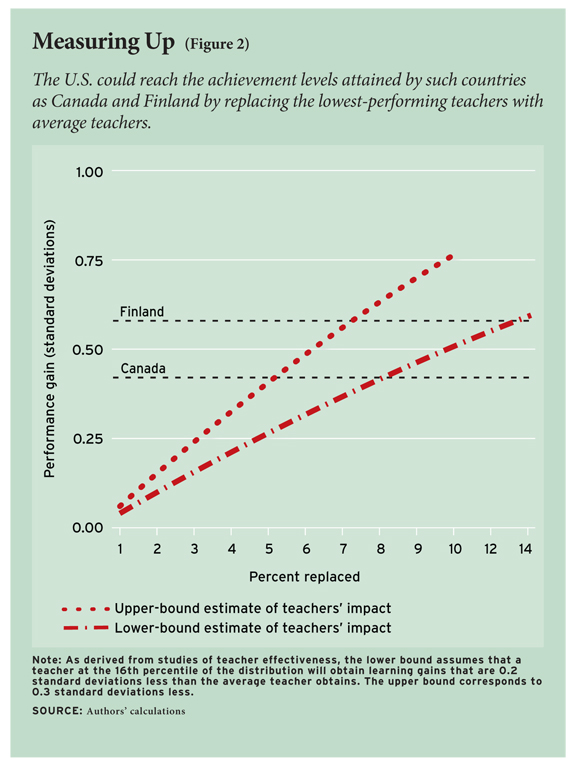Almost everybody concerned with educational policy agrees on two things: the U.S. has a very serious achievement problem and teachers are the most important element in our school for addressing this problem. Beyond these, agreement breaks down.
In the face of this I want to offer one simple thought: The future of our schools depends heavily on dealing with the small number of teachers who simply should not be in the classroom. Specifically, by replacing the bottom 5-10 percent of teachers with the average teacher found in today’s classrooms, research indicates that the achievement of U.S. students would rise from below the developed country average to near the top if not at the top. The gains to students and to the U.S. economy from that improvement are truly enormous – making it worth considering some alternation in current policies that ignore the problem.
It is useful review the evidence. The details surprise many who begin by accepting the opening line as being factual.
First, U.S. students are not competitive with those in other countries. They fall below students in the typical European country, comparing favorably to only students in a few such as Greece. On the PISA assessment of international math proficiency, the average U.S. student falls around the 34th percentile of Canadian students and the 28th percentile of Finnish students. Second, trailing, say Canada, by the amount we do acts as a brake on future economic growth, and the costs to the economy from lost growth are 25 times the costs of the current recession.
Third, and most important for this discussion, the variations in teacher effectiveness are huge, probably larger than most parents realize. Teacher effectiveness here is placed in simple terms – how much do students learn with a given teacher. Considerable research has gone into separating the impact of teachers on achievement from that of families, neighborhoods, and school peers. This research has produced extraordinarily consistent and similar results. From one perspective, a very good teacher can get a year and a half of student gain in learning over a school year, while a poor teacher gets half a year – a huge difference that leaves some students permanently harmed.

It turns out that overall impacts are particularly important at the bottom end of the teacher distribution. If, as noted, we could replace just the bottom 5-10 percent of teachers with an average teacher, we could expect the achievement of U.S. students to rise at least to the level of Canada and perhaps to Finland.
But think about it. Replacing the bottom 5-10 percent amounts to replacing two or three teachers in a school that has 30 teachers. Such a movement would not startle those in most businesses of the country. Surely it is less than seen in most law or accounting firms or in most hospitals.
Nobody doubts that there are teachers currently in our schools who should not be there. And, nobody doubts that the identity of these teachers is known to essentially everybody in the schools – from the principal, to the other teachers, to the students and parents, and to the union leaders.
Nonetheless, if one broaches this subject in schools, it is frequently labeled as anti-teacher. To the contrary, it is pro-teacher.
The good teachers in the school are simply hurt by being lumped together with the small number of teachers that are harming our kids. Indeed, it is almost certain that the prestige of the profession along with teacher salaries would rise significantly if the good teachers were not tarnished by the bad.
Let me close with a couple of responses to people who are critical of this view. First, nothing says that one should use test scores to decide who these ineffective teachers are. In fact test scores are essentially irrelevant, because of the obviousness of the identity of these bad teachers, an identity that would be revealed by virtually any sensible evaluation system.
Second, it does not say that we need to replace an additional 5-10 percent each year. If we once got the stock of teachers up to par, we need only worry about the small percentage of new teachers each year that fall below the acceptable range. We are talking about trimming out just the new teachers who prove to be ineffective, not additional existing teachers.
This is not a call for replacing all teachers. Nor is it a call for returning all female doctors and lawyers to classrooms. It is simply a call for applying standard management practices to schools. When we entrust our children to a school, we should be able to trust that they are not harmed.
[Note: this is the opening segment of an exchange on teacher policy with Diane Ravitch.]